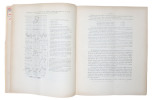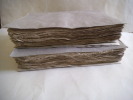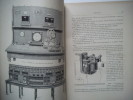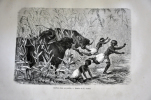-
Type
Book (1046)
Magazine (26)
Maps (3)
Photographs (2)
-
Latest
Last 24h (7)
Last 3 days (1)
Last month (9)
Last week (6)
-
Language
English (3)
French (1074)
-
Century
16th (1)
17th (1)
18th (24)
19th (135)
20th (218)
21st (64)
-
Countries
Belgium (127)
Canada (3)
Denmark (109)
France (758)
Switzerland (80)
-
Syndicate
ALAC (2)
ILAB (251)
NVVA (62)
SLACES (62)
SLAM (77)
Christophe Colomb raconté par son fils
Librairie Académique Perrin 1991 In-8 broché 22,5 cm sur 13,8. 265 pages. Très bon état d’occasion.
Très bon état d’occasion
"COMPTON, ARTHUR HOLLY. - THE DISCOVERY OF THE COMPTON-EFFECT, NOBEL PRIZE PAPER.
Reference : 47061
(1923)
A Quantum Theory of the scattering of X-Rays by Light Elements.
Lancaster, The Physical Review, 1923. Royal8vo. Contemp. full buckram. In:""The Physical Review"", Series II, vol. 21. (4),736 pp., Plates and textillustr. (Entire volume offered). A perforated stamp in upper margin on a few leaves. Compton's paper: pp. (483-) 501.
First printing of this milestone paper in quantum physics in which Compton verifies Planck's quantum postulate and found that some of the X-rays had, in scattering, lenghtened their wavelenght. This phenomena was called the ""Compton Effect"" in his honour. For this discovery Compton received the Nobel prize in physics in 1927.""Compton was able to account for this (lenghtening of wavelenght) by presuming that a photon of light struch an electron, which recoiled, subtracting some energy from the photon and therefore increasing its wavelenght. This made it seem that a photon acted as a particle: thus after more than a century, the particulate natuer of light, as evolved by Newton, was revived... What itamounted to was that Compton brought to fruition the view that electromagnetic radiation had both a wave aspect and a particle aspect, and that the aspect which was most evident depended on how the radiation was tested. De Broglie was, at the same time, showing that this held true also for ordinary particles, such as electrons."" (Asimov)Parkinson ""Breakthroughs"", 1923 P. - Sigmund Brandt ""The Harvest of as Century"", Episode 31.
Voyage dans le Nord de l’Allemagne, la Hollande et le Belgique.
In 8 broché, faux-titre, titre, 291 pages, 1 page de table Mme Vve BOUCHARD-HUZARD Mme MERCIER-Mme LACROIX et BAUDRY. J LOUVIER 1860. Edition originale
Voyage to the Pacific Ocean. 2nd Edition
" undertaken by the command of his majesty, for making discoveries in the Northern Hemisphere. Performed under the direction of captains Cook, Clerke and Gore, in his majesty's ships the Resolution and Discovery; in the years 1776, 1777, 1779, and 1780. IN THREE VOLUMES : Volume 1- 3; Vol. I and II written by Captain James Cook; Published by Order of the Lords Commissioners of the Admiralty, Vol. III by Captain James King . Second edition."
Ces trois livres sont brochés , ils sont à relier , un manque de pages de garde sur un tome ,beaucoup de cartes et croquis , photos sur demande
Vasiliki l'étrangleur.
1939 Agence Parisienne de Distribution Editeur, collection "REX" N° 11 - 1939 - 1 fascicule in-8, broché couverture illustrée - 63 pages
Rousseurs sur la couverture, tampons d'appartenance, sinon bon état.
Afghanistan. Royaume d'Asie Centrale. Ex. SIGNÉ.
Villeurbanne, F. O. T., 1969, gr. in-8vo, 219 p., rich. ill., Envoi ms. : A Madame Zwieck en hommage de (avec signature de l’auteur) 25.11.1970, cartonnage original ill.

(SLACES, NVVA)
Phone number : 41 (0)26 3223808
La centième anniversaire de la découverte du lac Tanganika (1858-1958).
Bruxelles, Académie royale des sciences coloniales, 1957. 16 x 24, 24 pp., broché, bon état.
envoi de l'auteur, tiré-à-part du Bulletin de l'Académie royale des sciences coloniales.
COSTABEL Pierre .- Conférence donnée au Palais de la Découverte - [Mathematique]
Reference : 2141
(1967)
Centre de gravité et équivalence dynamique D 34
1967 Paris Université de Paris Palais de la découverte 1955 Un volume in°12 broché 19 pages LR30
Très bon état bord de la couv un peu frottée N'hésitez pas à nous mettre dans vos favoris. Vous serez ainsi tenu au courant de nos nouveautés
COSTABEL Pierre .- Conférence donnée au Palais de la Découverte - [Mathematique]
Reference : 2135
(1967)
PIERRE VARIGNON (1654-1722) et la diffusion en France du calcul différentiel et intégral D 108
1967 Paris Université de Paris Palais de la découverte 1965 Un volume in°12 broché 28 pages LR30
Très bon état bord de la couv un peu frottée N'hésitez pas à nous mettre dans vos favoris. Vous serez ainsi tenu au courant de nos nouveautés
Paris New-York.
In 12 carré broché,78 pages, illustrations photographiques hors texte, Edition de la nouvelle revue critique sans date.
Chez nos indiens
Quatre années dans la Guyane Française 1877-1891. Petit in folio broché, couverture et dos illustrés. Faux-titre, frontispice (L’auteur) sous serpente, titre orné d’une vignette, 614 pages, 98 gravures dans le texte et à pleine page, une grande carte dépliante, en couleurs, en fin de volume. Edition originale. Envoi manuscrit autographe de l’auteur. Librairie Hachette & Cie 1893 rousseurs en début et fin de volume, couverture légèrement frottée, sinon bon exemplaire. Peu courant
Découverte d'une substance nouvelle dans le Vareck. (Annoncée par M. Clément). - Sur un nouvel acide formé avec la substance découverte par M. Courtois. - Note Sur la combinaison de l'iode avec l'oxigène" Par M. Gay-Lussac. - Lettre de M. Humphry ...
Paris, J. Klostermann, 1813. Contemp. hcalf. Spine gilt. A few scratches to binding. In: ""Annales de Chimie, ou Recueil de Mémoires concernant la Chemie"" Tome 88. - 336 pp. (the entire volume offered). Pp. 304-310, 311-318, 319-321 a. 322-329. Scattered brownspots.
First printing of this paper announcing the discovery of Iodine. Courtois found this substance, which he suspected to be a new element, while burning algae in order to obtain sodium and potassium compounds. Although Courtois discovered the element in 1811, the announcement of it was not made until two years later after he had turned it over to Charles Desormés and Nicolas Clément.""The first publication on iodine are somewhat confusing. Courtois's research is found in a paper attributed to him (the paper offered) but actually the work of Clément.... was followed by an anonymous article (the second paper offered). Gay-Lussac. who repeated and extended Courtios's work, was responsible for this paper. Courtois himself published nothing. These two articles were immediately followed by short contributions of Gay-Lussac and Humphry Davy on the new element (third and fourth paper offered). Gay-Lussacs views (none too flattering to Davy) on the history ofthe discovery of iodine appeared in his ""Mémoire sur l'iode"" (1814).""(DSB III, p. 455). - Weeks ""Discovery of the Elements"", pp. 257-262.The volume contains further importent papers in chemistry, Guyton de Morveau ""Sur la chaux maigre"", ""Sur le dissolvant des pierres biliaires"", an importent paper by Chevreul on animal fats ""Recherches chimiques sur plusieurs corps gras, et particulierement sur leurs combinaisons avec les alcalis"", Berzelius's papers ""Mémoires sur la compositions des fluides animaux"" (first edition in French) + Suite (first edition), Parmentier etc. etc.
Méditerranée.
Lausanne, La Guilde du Livre, 1957 22 x 28, 92 pp., très nombreuses illustrations (photos en N/B), cartonnage souple d'édition + jaquette rempliée, papier cristal d'origine parfaitement conservé, très bon état.
"photographies de Henriette Grindat; édition originale, N° 180, hors commerce."
L'Espagne pittoresque, artistique et Monumentale, moeurs, usages et costumes.
In 8 reliure éditeur demi-cuir, titre et décor dorés en long au dos, plats percaline noire avec une grande plaque dorée animée sur premier plat petite plaque dorée sur le deuxième plat.Filets à froid en encadrement.faux-titre,frontispice (Isabelle II) titre,392 pages,deux feullets de table,chapitre et placement des gravures. Cinquante gravures hors texte de Célestin NANTEUIL,sous serpentes dont vingt cinq en couleurs gommées, cent bois dans le texte.Librairie ethnographique éditeur sans date. (1848)Edition originale (Vicaire volume II page 1074, Carteret volume III page 222)rousseurs habituelles. Une mouillure en tête s'amenuisant au fil des pages pour redevenir plus importante de la page 391 à la fin. Un vignette de collection a été collée sur la page de faux titre.
"CURIE, IRÈNE et M.F. JOLIOT. - ANNOUNCING THE DISCOVERY OF ARTIFICIAL RADIOACTIVITY - NOBEL PRIZE PAPER OF 1935.
Reference : 47071
(1934)
Un nouveau type de radioactivité. (Séance du 15 Janvier 1934).
Paris, Gauthier-Villars, 1934. 4to. No wrappers. In: ""Comptes Rendus Hebdomadaires des Séances de L'Academie des Sciences"", Tome 198 No 3. Titlepage to vol. 198. Pp. (213-) 292. (Entire issue offered). The joint paper: pp. 254-256 a. 1 photographic illustration in the text. Titlepage with a stamp on verso, 2 small tears and a tiny bit of upper right corner gone. Titlepage a bit browned.
First appearance of this seminal paper in which artificial radioactivity was announced for the first time. Curie and Joliot were awarded the Nobel Prize in Chemistry 1935 ""in recognition of their synthesis of new radioactive elements"".""Until this date (1934), atomic nuclei emitting radiation were found in nature: it was called the natural radioactivity. It had been known since Rutherford that this natural radioactivity changed a nucleus into an other one: for instance radium becomes finally lead after many radioactive decays. We could say that lead does not become gold but gold becomes lead! But... this change of matter was not under control. It was not possible to construct the desired chemical element as the alchemist dreamed... But Irene and Frederic Joliot-Curie, made the dream become almost reality.""""Another very important development in the early 1934 by the Joliot-Curies in connection with irradiation of aluminum by alpha particles. The two French scientists detected the production of the recently discovered positrons. [...] However, they soon realized that the positron activity continued after the alpha source was removed and that they had, in fact, discovered positive beta radioactivity. The importance of the discovery of artificial radioactivity was immediately recognized and resulted in a Nobel Prize in chemistry to the Joliot-Curies in 1935. The new phenomenon immediately became widely employed in nuclear physics, chemistry, biology, and medicine."" (Kragh, Quantum Generations, p. 187)""These elegant experiments, which provided the first chemical proof of induced transmutations and showed the possibility of artificially creating radioisotopes of known stable elements, were repeated and extended in the major nuclear physics laboratories of various countries "" (DSB).Born on 12 September 1897 in Paris, Irène Curie was the daughter of Pierre and Marie Curie. ""During World War I, she worked as a nurse, helping her mother operate radiography equipment, and then studied physics and mathematics at the Sorbonne, gaining a doctorate for studying the range of alpha particles. She then went to work for her mother at the Radium Institute. There she met Frédéric Joliot whom she married in 1926. Frédéric Joliot was born on 19 March 1900 in Paris - He joined the Radium Institute in 1925 and obtained his PhD in 1930. Together the Joliot-Curies worked on radioactivity and the transmutation of the elements. Twice they just missed major discoveries: in 1932 when Chadwick beat them to the neutron, and in 1933 when Anderson discovered the positron. However, in 1934, whilst bombarding light elements with alpha particles, the Joliot-Curies noticed that, although proton production stopped when the alpha particle bombardment stopped, another form of radiation continued. The alpha particles had produced an isotope of phosphorus not found in nature. This isotope was radioactive and was decaying through beta-decay"" (DSB).
"CURIE, JACQUES et PIERRE. - THE DISCOVERY OF PIEZOELECTRICITY.
Reference : 47008
(1880)
Développement, par pression, de l'èlectricité polaire dans les cristaux hémièdres à faces inclinées. Note de MM. Jacques et Pierre Curie, présentée par M. Friedel.
Paris, Gauthier-Villars, 1880. 4to. No wrappers. In: ""Comptes Rendus Hebdomadaires des Séances de L'Academie des Sciences"", Tome 91, No 5 (entire issue offered). Pp. 251-310. The Curie's paper: pp. 294-295.
First apperance of the paper in which the two brothers announced their discovery of the Piezoelectric Effect, as they observed how an electric potential appeared across crystals of quartza and of Rochelle salt when pressure was applied to them. The potential varied directly with the pressure, and they named the phenomenon Piezoelectricity, meaning ""to press"" (Greek). Crystals with piezoelectric properties form an essential portion of sound-electronics devices such as microphones and record-players.""The applications of piezoelectric crystals are innumerable"" one of the most important is their use in frequency stabilization of oscillating electromagnetic cirasciots for radio broadcasting stations. They are used in most piezometers for measuring with great precision either very strong pressure variations, such as those of a cannon at the moment of firing, or very weak ones, such as artery pulsations. These applications have led to the creation of a new industry, the manufacture of large ""mono"" such as quartz obtained hydrothermally around 500°C. under high water pressures, or crystals such as Rochelle salt, obtained from aqueous solutions. These two substances were mentioned in the Curie brothers’ report announcing the discovery of piezoelectricity."" (DSB).""The first experimental demonstration of a connection between macroscopic piezoelectric phenomena and crystallographic structure was published in 1880 by Pierre and Jacques Curie. Their experiment consisted of a conclusive measurement of surface charges appearing on specially prepared crystals (tourmaline, quartz, topaz, cane sugar and Rochelle salt among them) which were subjected to mechanical stress. These results were a credit to the Curies' imagination and perseverance, considering that they were obtained with nothing more than tinfoil, glue, wire, magnets and a jeweler's saw."" (Piezo Systems, Inc.).Magee ""A Source Book in Physics"", p. 547 ff.
"CURIE, (MARIE) SKLODOWSKA. - THE DISCOVERY OF THE RADIOACTIVITY OF THORIUM - COINING THE TERM 'RADIOACTIVITY'
Reference : 46852
(1898)
Rayons émis par les composés de l'uranium et de thorium. Presentée par M. Lippmann. Séance du Mardi 12 Avril 1898).
Paris, Gauthier-Villars, 1898. 4to. No wrappers. In: ""Comptes Rendus Hebdomadaires des Séances de L'Academie des Sciences"", Tome 126, No 15). Entire issue offered. With htitle and titlepage to vol. 126. Pp. 1059-1110. Curie's paper: pp. 1101-1103.
First printing of this milestone paper, being the first ""Note"" from Marie Curie about ""radioactivity"". This same ""Note"" contains a the fundamental observation: ""Two uranium ores... are much more active than uranium itself. This fact... leads one to believe that these ores may contain an element much more active than uranium."" This paper gives the first proof of the fact that radiation is an atomic property.""Henri Becquerel, discovered (1896) that uranium salts shielded from light for several months spontaneously emit rays related in their effects to Roentgen rays. Mme. Curie became enthusiastic about this subject filled with the unknown and, as she later acknowledged, involving no bibliographic research.The first step in the research was to determine whether there existed other elements capable, like uranium, of emitting radiation. Abandoning the idea of hyperfluorescence, couldn’t one calculate by electrical measurement the effects on the conductivity of air that were revealed by the gold-leaf electroscope? Pierre Curie and his brother Jacques had constructed an extremely sensitive apparatus to measure weak currents"" Mme. Curie employed it in testing both pure substances and various ores. In her first ""Note"" in the Comptes rendus""de l Académie des sciences (12 April 1898) she described the method that she followed throughout her life, the method that enabled her to make comparisons through time and crosschecks with other techniques:""I employed... a plate condenser, one of the plates being covered with a uniform layer of uranium or of another finely pulverized substance [(diameter of the plates, eight centimeters"" distance between them, three centimeters). A potential difference of 100 volts was established between the plates.]. The current that traversed the condenser was measured in absolute value by means of an electrometer and a piezoelectric quartz. In general she preferred the zero method, in which the operator compensates for the current created by the active material by manipulating the quartz. All of her students followed this procedure.""(DSB).The first results came in 1898: the measurements varied between 83 × 10-12 amperes for pitch blende to less than 0.3 × 10-12 for almost inactive salts, passing through 53 × 10-12 for thorium oxide and for chalcolite (double phosphate of uranium and copper). Thorium would thus be ""radioactive"" (the term is Mme. Curie’s" its radioactive properties were discovered at the same time, independently, by Schmidt in Germany.
Voyage aux Etats-Unis d'Amérique ou observations sur la société, les moeurs, les usages et le gouvernement de ce pays receuillis en 1818-1819 et 1820.
Deux tomes en deux volumes in 8 brochés,papier gris d'attente, étiquettes de titre imprimée.Tome premier: Faux-titretitre,XIV, 350 pages Tome deuxième: faux-titre,titre,359 pages. non rognés.Une carte gravée, dépliante, de la partie Nord de l'Amérique Septentrionale a été ajoutée.Traduit de l'anglais sur la seconde édition par J.T PARISOT.Bon exemplaire à grandes marges.
Voyage d’un naturaliste autour du monde
Voyage d’un naturaliste autour du monde fait à bord du navire le Beagle de 1851 à 1856. Traduit de l’anglais par E.D BARBIER.. Deuxième édition. In 8 cartonné, reliure muette 150x2140mm, Faux titre, titre préface de l’auteur, du traducteur- seconde préface X+VIII, 552 pages, non rogné, catalogue de 18 pages, des livres du fonds de G.REINWALD décembre 1886. Couverture papier bleu. Paris C REINWALD libraire éditeur 1883. (Marge inférieure plus courte à la page de faux-titre- ainsi qu’à la page I de la préface- petite déchirure, réparée en marge extérieure, page de titre) quelques figures dans le texte, bon état d’ensemble.
A travers l’électricité.
Grand in 8 reliure éditeur pleine toile verte, avec scène animes dorée sur le premier plat: tramway électrique dos avec titre illustré : un téléphone, dorés, faux-titre, titre illustré avec mention de quatrième édition, un tampon de bibliothèque angle supérieur droit , tranches dorées, 400 illustrations dans le texte et à pleine page. Vuibert & Nony éditeurs, sans date, rousseurs éparses habituelles, plus concentrées en début et fin de volume. Beau cartonnage avec dorure éclatante. Bon exemplaire
Tout par l'électricité. 2è édition
Mame In-8 Couverture rigide Tours 1883
Bon 479 pages. Ex libris de remise de prix d'excellence en page de garde, tache sur la page de titre. Nombreuses planches noir et blanc. L'auteur démontre les diverses applications de l'électricité : lampes, passages à niveau, etc.
Exploration du Zambèse et de ses affluents et découverte des lacs Chiroua et Nyassa (1858-1864)
1866 Hachette 1866 broché : 580 pages Bon exemplaire.
Some experiments on a solid compound of iodine and oxygene, and on its chemical agencies. Read April 20, 1815. (+) On the action of acids on the salts usually called hyperoxymuriates. Read May 4, 1815. (2 papers).
(London, W. Bulmer and Co., 1815). 4to. No wrappers as extracted from ""Philosophical Transactions"" 1815 - Part II. Pp. 203-213 a. pp. 214-219.
First appearance of two importent papers by davy. In the second paper offered, he relates his discovery of chlorine dioxyd.""By explosion over mercury he found that 2 vols. give from 2.7 to 2.9 of gas, and this would probably be 3 vols. if no chlorine had been absorbed by the mercury. This gas contains 2 vols. of oxygen and the remainder chlorine, hence the compound consists of 'two in volume of oxygen and one of chlorine, condensed into the space of two volumes' (ClO2). He found it to explode at about 100 deg. with more viollence than euchlorine.""(Partington III, p. 57).Together with ROBERT PORRETT ""Further analytical experiments relative to the constitution of the prussic" of the ferruretted chyazic, and of the sulphuretted chyazic acids and of their salts" together with the application of the atomic theory to the analysis of these bodies."", pp. 220-230 a. 2 tables, one folding.
"DAVY, HUMPHRY - THE DISCOVERY OF HYDROGEN TELLURIDE - THE RIVALRY WITH GAY-LUSSAC & THENARD.
Reference : 46377
(1810)
Nouvelles Recherches électro-chimiques, principalement relatives aux substances métalliques tirées des alcalis et de terres, et à quelques combinations de l'Hydrogène. (+) Suite des Recherches... (+) Sur les Observations sur les Recherches faites p...
Paris, J. Klostermann, 1810. Contemp. hcalf. Spine gilt. Slightly rubbed. A few scratches to binding. Small stamps on verso of titlepage.In: ""Annales de Chimie, ou Recueil de Mémoires concernant la Chemie"" Tome 75. 336 pp. a. 2 folded engraved plates. Some scattered brownspots. The papers: pp. 27-77, 129-175, 256-263, 264-273, 274-289 a. 290-316.
First French version of Davy's ""The Bakerian Lecture for 1809. On some new Electrochemical Researches, on various Objects, particularly the metallic Bodies, from the Alkalies, and Earth, and on some Combinations of Hydrogene. Read November 16, 1809."", together with the controversy papers by Davy and Gay-Lussac & Thenard.""Mr. Davy having from the commencement of his electro-chemical researches, communicated the several steps of his progress to the Society (The Royal Society), takes the present opportunity of reporting the results of his further inquiries under four principal heads. First, on the nature of the metals of the fixed alkalis. Second, on the nature of Hydrogen and composition of ammonia. Thirdly, on the metals of the earth"" and Fourthly he makes a comparison between the antiphlogistic doctrine, and a modified phlogistic hypothesis.""(Abstract). He further gives arguments for considering potassium and sodium, which he discovered in 1808, as a element.""""Gay-Lussac had a slight rivalry between himself and the creation scientist Sir Humphry Davy. Davy was chemically preparing Potassium and Sodium through an electrical current, and this made Gay-Lussac and Thénard envious of his success. They too decided to perform the same task, but they had no battery at their disposal as Davy had, so they had to form another way to chemically prepare the two elements. In 1808, they used a red-hot iron fused to potash, the water-soluble form of a manufactured salt containing potassium, to perform this task, a method that Davy admitted had its advantageous qualities. Gay-Lussac and Thénard were successful in preparing Potassium, and continued to make a full analysis of its chemical properties, and began to use it for their own experiments. In 1809, Davy performed the same task, using it to reduce Boron in Boracic acid.""
The Bakerian Lecture for 1809. On some new Electrochemical Researches, on various Objects, particularly the metallic Bodies, from the Alkalies, and Earth, and on some Combinations of Hydrogene. Read November 16, 1809.
(London, W. Bulmer and Co., 1810). 4to. No wrappers as extracted from ""Philosophical Transactions"" 1810 - Part I. Pp. 16-74 and 2 engraved plates showing Davy's electrochemical apparatus for decomposing substances. The plates dampstained. Text fine and clean.
First appearence of this historical chemical paper, Davy' fifth Bakerian Lecture, in which he announced his discovery of hydrogen telluride.""Mr. Davy having from the commencement of his electro-chemical researches, communicated the several steps of his progress to the Society (The Royal Society), takes the present opportunity of reporting the results of his further inquiries under four principal heads. First, on the nature of the metals of the fixed alkalis. Second, on the nature of Hydrogen and composition of ammonia. Thirdly, on the metals of the earth"" and Fourthly he makes a comparison between the antiphlogistic doctrine, and a modified phlogistic hypothesis.""(Abstract). He further gives arguments for considering potassium and sodium, which he discovered in 1808, as a element.""Humphry Davy was one of the most brilliant chemists of the early nineteenth century. His early study of nitrous oxide brought him his first reputation, but his later and most importent investigations were devoted to electrochemistry. Following Galvani's experiments and the discovery of the voltaic pile, interest in galvanic electricity had become widespread. The first electrolysis by means of the pile was carried out in 1800 by Nicholson and Carisle, who obtained oxygen and hydrogen from water. Davy began to examine the chemical effects of electricity in 1800, and his numerous discoveries were presented in his Bakerian lectures."" - Wheeler Gift: 2518.
 Write to the booksellers
Write to the booksellers


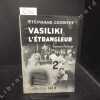
![Centre de gravité et équivalence dynamique D 34. COSTABEL Pierre .- Conférence donnée au Palais de la Découverte - [Mathematique]](https://static.livre-rare-book.com/pictures/RLI/2141_1_thumb.jpg)










